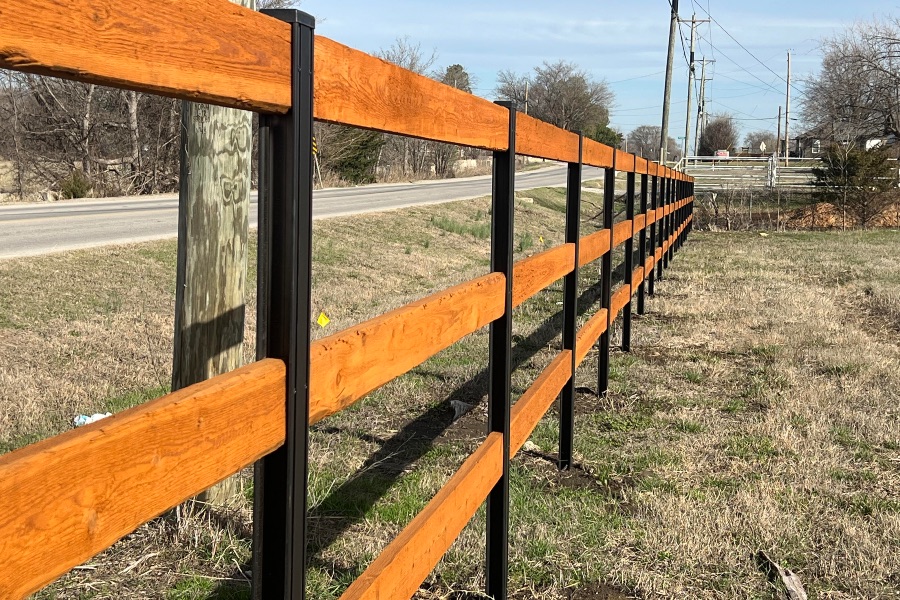All Categories
Featured
Mounting a fencing around your building can boost privacy, safety, and visual appeals. Nevertheless, before getting going, it's important to establish whether you need an authorization for the installation. Different locations have varying laws, and recognizing what's required will certainly assist make sure that your fence is legal, safe, and built according to regional standards. Right here's a guide to aid you browse the permitting process for fence installation.
Why Are Allows Needed? Permits are needed to guarantee that the installment of your fence satisfies local building ordinance and zoning legislations. These laws remain in location to maintain the safety, appearance, and functionality of residential properties in your neighborhood. Furthermore, permits help prevent disagreements with next-door neighbors concerning building lines, fence height, and various other architectural details.
Regional authorities need licenses to keep an eye on points like presence at crossways, public safety, and prospective damage to energies like water pipes or electrical lines. The procedure helps keep your fence task certified with safety and legal requirements.
Kinds Of Licenses You May Need. The precise authorizations called for can vary depending on your location and the specifics of your job. Below are the most typical types of licenses you may require:
Structure Authorization. Many cities and counties call for a structure permit for fences that exceed a specific height, typically over 6 feet. This license makes certain that your fence conforms with architectural standards, specifically if it's made from certain products such as concrete, metal, or block. Structure licenses are likewise necessary when your fence influences the total landscape, like creating an or obstructing a sightline.
Zoning License. Zoning licenses are released to guarantee that your fence conforms with neighborhood zoning laws. These laws may regulate where fencings can be placed on your home (e.g., front, side, or backyard), how high they can be, and whether they can be installed near pathways or roads. Zoning legislations are put in place to preserve the general aesthetic appeals of communities and keep traffic security.
Obstacle License. Some locations have problem laws that establish how far a fencing must be from the residential property line, roadway, or specific public rooms. Problem licenses are designed to make sure that your fence doesn't hinder surrounding properties or public areas. A property survey may be called for to confirm residential or commercial property lines before acquiring this kind of authorization.
HOA Authorization. You may require to obtain authorization from the HOA before setting up a fencing if you live in a community regulated by a Homeowners Association (HOA) HOAs usually have strict standards concerning the kind of fence allowed the area, including its material, shade, and height. Always consult the HOA prior to starting your job to avoid any type of disputes.
Just How to Get a Fencing Permit. The process for acquiring an authorization usually entails a number of steps:
Research Study Local Laws. Begin by inspecting your city or area's site to learn the particular demands for fence installment. You may require to see the neighborhood planning or building department in individual for more in-depth info.
Prepare Your Application. The majority of cities will certainly call for an application, which includes information about your intended fence, such as:
![]()
The kind of fence product (timber, vinyl, chain-link, and so on) The planned height of the fence. The place and measurements of the fence. A home survey (to validate residential property lines) Send the Application. After completing the application, submit it to the local structure or zoning workplace. You may be called for to pay a cost relying on your area and the dimension of your fencing. Charges can vary, but they generally cover the price of processing your request and evaluating your plans.
Await Approval. Once your application is submitted, the local authorities will certainly assess your strategies to guarantee they meet zoning and developing requirements. This procedure can take anywhere from a couple of days to a number of weeks, relying on the complexity of the job and the quantity of permit demands in your area.
![]()
If Needed),Examination (. In many cases, you may require to set up an inspection after the fencing is mounted to guarantee it fulfills the called for criteria. Your regional office will let you know if this action is required.
When You Do Not Need a Permit. Not every fence setup requires a permit. Some scenarios where you may not need a permit include:
Installing a fence that's under a certain elevation (frequently 3-4 feet for front yards) Changing an existing fencing with one that is the same height and product. Setting up a short-term fencing (e.g., for construction or horticulture) Nevertheless, even if your project seems little, it's constantly suggested to contact regional authorities to make certain you're following the correct procedure.
Effects of Not Obtaining an Authorization. Mounting a fence without the needed permit can result in substantial effects, consisting of penalties, removal of the fencing, and pricey reinstallation. In many cases, neighborhood authorities may need you to customize the fence if it doesn't fulfill code needs. Additionally, not getting an authorization can develop conflicts with next-door neighbors, particularly if the fencing is placed incorrectly or breaks local height guidelines.
Verdict. Before mounting a fence, it's crucial to investigate the details allowing needs in your location. Get in touch with your neighborhood structure or zoning division to figure out if a license is essential and to ensure that you're adhering to the correct procedure. By safeguarding the appropriate licenses, you'll guarantee and prevent lawful problems that your fencing installment is safe, compliant, and hassle-free.
Why Are Allows Needed? Permits are needed to guarantee that the installment of your fence satisfies local building ordinance and zoning legislations. These laws remain in location to maintain the safety, appearance, and functionality of residential properties in your neighborhood. Furthermore, permits help prevent disagreements with next-door neighbors concerning building lines, fence height, and various other architectural details.
Regional authorities need licenses to keep an eye on points like presence at crossways, public safety, and prospective damage to energies like water pipes or electrical lines. The procedure helps keep your fence task certified with safety and legal requirements.
Kinds Of Licenses You May Need. The precise authorizations called for can vary depending on your location and the specifics of your job. Below are the most typical types of licenses you may require:
Structure Authorization. Many cities and counties call for a structure permit for fences that exceed a specific height, typically over 6 feet. This license makes certain that your fence conforms with architectural standards, specifically if it's made from certain products such as concrete, metal, or block. Structure licenses are likewise necessary when your fence influences the total landscape, like creating an or obstructing a sightline.
Zoning License. Zoning licenses are released to guarantee that your fence conforms with neighborhood zoning laws. These laws may regulate where fencings can be placed on your home (e.g., front, side, or backyard), how high they can be, and whether they can be installed near pathways or roads. Zoning legislations are put in place to preserve the general aesthetic appeals of communities and keep traffic security.
Obstacle License. Some locations have problem laws that establish how far a fencing must be from the residential property line, roadway, or specific public rooms. Problem licenses are designed to make sure that your fence doesn't hinder surrounding properties or public areas. A property survey may be called for to confirm residential or commercial property lines before acquiring this kind of authorization.
HOA Authorization. You may require to obtain authorization from the HOA before setting up a fencing if you live in a community regulated by a Homeowners Association (HOA) HOAs usually have strict standards concerning the kind of fence allowed the area, including its material, shade, and height. Always consult the HOA prior to starting your job to avoid any type of disputes.
Just How to Get a Fencing Permit. The process for acquiring an authorization usually entails a number of steps:
Research Study Local Laws. Begin by inspecting your city or area's site to learn the particular demands for fence installment. You may require to see the neighborhood planning or building department in individual for more in-depth info.
Prepare Your Application. The majority of cities will certainly call for an application, which includes information about your intended fence, such as:

The kind of fence product (timber, vinyl, chain-link, and so on) The planned height of the fence. The place and measurements of the fence. A home survey (to validate residential property lines) Send the Application. After completing the application, submit it to the local structure or zoning workplace. You may be called for to pay a cost relying on your area and the dimension of your fencing. Charges can vary, but they generally cover the price of processing your request and evaluating your plans.
Await Approval. Once your application is submitted, the local authorities will certainly assess your strategies to guarantee they meet zoning and developing requirements. This procedure can take anywhere from a couple of days to a number of weeks, relying on the complexity of the job and the quantity of permit demands in your area.

If Needed),Examination (. In many cases, you may require to set up an inspection after the fencing is mounted to guarantee it fulfills the called for criteria. Your regional office will let you know if this action is required.
When You Do Not Need a Permit. Not every fence setup requires a permit. Some scenarios where you may not need a permit include:
Installing a fence that's under a certain elevation (frequently 3-4 feet for front yards) Changing an existing fencing with one that is the same height and product. Setting up a short-term fencing (e.g., for construction or horticulture) Nevertheless, even if your project seems little, it's constantly suggested to contact regional authorities to make certain you're following the correct procedure.
Effects of Not Obtaining an Authorization. Mounting a fence without the needed permit can result in substantial effects, consisting of penalties, removal of the fencing, and pricey reinstallation. In many cases, neighborhood authorities may need you to customize the fence if it doesn't fulfill code needs. Additionally, not getting an authorization can develop conflicts with next-door neighbors, particularly if the fencing is placed incorrectly or breaks local height guidelines.
Verdict. Before mounting a fence, it's crucial to investigate the details allowing needs in your location. Get in touch with your neighborhood structure or zoning division to figure out if a license is essential and to ensure that you're adhering to the correct procedure. By safeguarding the appropriate licenses, you'll guarantee and prevent lawful problems that your fencing installment is safe, compliant, and hassle-free.
Latest Posts
Find the Greatest Auto Repair Offers in Montclare, Chicago
Published May 27, 25
1 min read
Uncover Cost-Effective Auto Repairs with Montclare’s Exclusive Service Specials
Published May 25, 25
1 min read
Understanding Roof Covering Guarantees: What Homeowners Need To Know
Published May 24, 25
1 min read